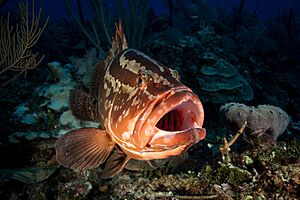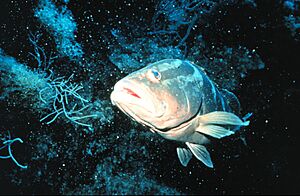Nassau grouper facts for kids
Quick facts for kids Nassau grouper |
|
|---|---|
 |
|
| Conservation status | |
| Scientific classification | |
| Synonyms | |
|
The Nassau grouper (Epinephelus striatus) is a large fish that lives near coral reefs. It belongs to a group of fish called groupers. This fish is very important for fishing in the West Indies. However, its numbers have dropped a lot because of too much fishing.
The International Union for Conservation of Nature says the Nassau grouper is critically endangered. This means it is at a very high risk of disappearing forever. Fishing for this species is not allowed in US federal waters. The US government also lists it as a threatened species.
Contents
What the Nassau Grouper Looks Like
The Nassau grouper is a medium to large fish. It can grow to be over one meter (about 3 feet) long. It can also weigh up to 25 kilograms (about 55 pounds). This fish has a thick body and a big mouth. It uses its mouth to "inhale" its food.
Its color can change depending on where it lives. In shallow water, it is usually a brownish-yellow color. But in deeper water, it can be pink, red, or even orange-red. It also has lighter stripes and darker spots on its body. You can see black spots near its eye. There is also a special forked stripe on top of its head.
Where Nassau Groupers Live
The Nassau grouper lives in the ocean close to coral reefs. It is one of the biggest fish you can find around these reefs. You can find them from the shoreline down to almost 100 meters (about 330 feet) deep.
They live in the western Atlantic Ocean and around the Caribbean Sea. This includes places like Bermuda, Florida, and the Bahamas. They can also be found along the eastern coast of Venezuela. However, they are rare in the Gulf of Mexico, except near the coast of Belize.
Nassau Grouper Life Cycle
The Nassau grouper usually lives alone. It hunts for food during the day. Its main diet includes other fish and small crustaceans. These crustaceans are things like crabs and small lobsters.
These groupers gather to mate in December and January. This always happens around the time of the full moon. They also meet in the same special places every year. Many groupers come together to lay their eggs and fertilize them. This is called mass spawning.
Protecting the Nassau Grouper
People fish for the Nassau grouper for both business and fun. This fish is not as shy as other groupers. This makes it easier for divers to get close to them. But their numbers have dropped a lot because of too much fishing. They also reproduce slowly.
Their special mating spots are easy targets for fishing. This means many adult groupers are caught when they are trying to reproduce. Because of this, the species is very easy to overfish. The IUCN Red List now calls it critically endangered.
Governments are trying to help. The United States, the Cayman Islands, and the Bahamas have banned fishing for them. They have also set up times when fishing is not allowed. For example, in the Bahamas, fishing for Nassau grouper is banned from December to February. This helps protect them during their breeding season.
A big mating site for these fish is at Glover's Reef in Belize. This is one of only two important sites left for the species. In 2002, a special protected area was made there. However, the exact mating spot is not inside this protected area. Instead, it has a three-month fishing ban during winter mating times.
Many ways to protect the grouper are now in place. These include closed seasons when fishing is not allowed. Only fish over 3 pounds can be caught. This gives younger fish a chance to grow and reproduce. Some areas are fully protected. Also, fishing for the grouper is completely banned in US waters. Protecting their mating sites at all times is also happening in some places.
The population of Nassau groupers is still decreasing. They need healthy coral reefs to survive. Their future is not looking very good right now.
Images for kids
The Nassau grouper has even been shown on postage stamps. These include stamps from Cuba (1965, 1975), the Bahamas (1971), and Antigua and Barbuda (1987).
The main dangers to the grouper are too much fishing and fishing during their breeding time. Other threats include losing their homes, pollution, and catching fish that are too small.
The Nassau grouper was put on the World Conservation Union's red list in 1996. It was listed as endangered because its population had dropped by 60% in 30 years. More than a third of their mating groups have disappeared. In some areas, there are so few groupers left that they are considered "commercially extinct." This means there are not enough to fish for business.





